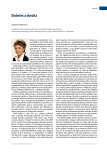New classes of antidiabetic drugs: DPP4 inhibitors and SGLT2 inhibitors in the treatment of a patient with type 2 diabetes and obesity
Authors:
Vladimír Uličiansky
Authors‘ workplace:
Via medica, s. r. o.
Published in:
Forum Diab 2016; 5(1): 17-22
Category:
Topic
Overview
Dipeptidyl peptidase 4 (DPP4) inhibitors (sitagliptin, vildagliptin, saxagliptin, linagliptin, alogliptin) and sodium glucose cotransporter 2 (SGLT2) inhibitors (dapagliflozin, canagliflozin, empagliflozin) are new therapies for type 2 diabetes mellitus. They can be used alone or in combination with other glucose-lowering agents. DPP4 inhibitors exert antihyperglycemic effects by inhibiting DPP4 and thereby enhancing levels of GLP-1. DPP-4 inhibitors are weight neutral. SGLT2 inhibitors have a glucosuric effect that results in decreased HbA1c, weight and systolic BP. The differing modes of actions of these therapies produce varied efficacy and tolerability profiles and additional treatment benefits beyond glycemic control.
Key words:
type 2 diabetes – DPP4 inhibitors – SGLT2 inhibitors – body weight
Sources
1. Uličiansky V, Schroner Z, Némethyová Z et al. Personalizovaná medicína v diabetológii v kontexte odporúčaní ADA/EASD 2015. Forum Diab 2015; 4(2): 102–118.
2. Inzuchi SE, Bergenstal RM, Buse JB et al. Management of hyperglycemia in type 2 diabetes, 2015: a patient-centered approach: update to a position statement of the American Diabetes Association and the European Association for the Study of Diabetes. Diabetes Care 2015; 38(1): 140–149.
3. Garber AJ, Barzilay J, Bloomgarden ZT et al. Consensus statement by the American Association of Clinical Endocrinologists and American College of Endocrinology on the comprehensive type 2 diabetes management algorithm – 2016 executive summary. Endocr Pract 2016; 22(1): 84–113.
4. Schroner Z, Uličiansky V. Inhibítory dipeptidyl-peptidázy-4 – základná charakteristika a mechanizmus účinku. In: Schroner Z, Uličiansky V. Liečba diabetes mellitus 2. typu založená na účinku inkretínov. 2. ed. SchronerMed: Košice 2011: 41–62. ISBN 9788097071479.
5. Nauck M. Incretin therapies: highlighting common features and differences in the modes of action of glucacon-like-peptid-1 receptor agonists and dipeptidyl peptidase-4 inhibitors. Diabetes Obes Metab 2016; 18(3): 203–216.
6. Egan AG, Blind E, Dunder K et al. Pancreatic safety of incretin-based drugs. FDA and EMA assessment. N Engl J Med 2014; 370(9): 794–797.
7. Okša A, Ponťuch P, Spustová V et al. Diabetická nefropatia: Diagnostika, prevencia a liečba. Odporúčané postupy Slovenskej nefrologickej spoločnosti a Slovenskej diabetologickej spoločnosti. Forum Diab 2013; 2(2 Suppl 1):1–6.
8. White WB, Cannon CHP, Heller SR et al (EXAMINE Investigators). Alogliptin after Acute Coronary Syndrome in Patients with Type 2 Diabetes. N Engl J Med 2013; 369(14): 1327–1335.
9. Scirica BM, Bhatt DL, Braunwald E et al (SAVOR-TIMI 53 Steering Committee and Investigators). Saxagliptin and Cardiovascular Outcomes in Patients with Type 2 Diabetes Mellitus. N Engl J Med 2013; 369(14): 1317–1326.
10. Gree JB, Bethel MA, Armstrong PW et al (TECOS Study Group). Effect of Sitagliptin on Cardiovascular Outcomes in Type 2 Diabetes. N Engl J Med 2015; 373(3): 232–242.
11. Abbas AS, Dehbi HM, Ray KK. Cardiovascular and non-cardiovascular safety of dipeptidyl peptidase-4 inhibition: a metaanalysis of randomized controlled cardiovascular outcome trials. Diabetes Obes Metab 2016; 18(3): 295–299.
12. Bays H. Sodium Glucose Co-transporter Type 2 (SGLP2) Inhibitors: Targeting the Kidney to Improve Glycemic Control in Diabetes Mellitus. Diabetes Ther 2013; 4(2): 195–220.
13. DeFronzo RA, Davidson JA, Del Prato S. The role of the kidneys in glucose homeostasis: a new path towards normalizing glycaemia. Diabetes Obes Metab 2012; 14(1): 5–14.
14. Uličiansky V. Nová stratégia v liečbe diabetu mellitus 2. typu – inhibícia renálnej reabsorpcie glukózy. Interná Med 2014; 14(4): 179–185.
15. Schroner Z, Uličiansky V. Inhibítory SGLT2 – nová cesta v liečbe diabetes mellitus 2. typu. SchronerMED: Košice 2015: 9–56. ISBN: 978–80–8129–040–4.
16. Rajeev SP, Cuthbertson DJ, Wilding JPH. Energy balance and metabolic changes with sodium-glucose co-transporter 2 inhibition. Diabetes Obes Metab 2016; 18(2): 125–134.
17. Bolinder J, Ljunggren O, Kullberg J et al. Effects of dapagliflozin on body weight, total fat mass and regional adipose tissue distribution in patients with type 2 diabetes mellitus with inadequate glycemic control on metformin. J Clin Endocrinol Metab 2012; 97(3): 1020–1031.
18. KDIGO 2012. Clinical Practice Guideline for the Evaluation and Management of Chronic Kidney Disease. Kidney Int Suppl 2013; 3(1): 1–150. Dostupné z WWW: <http://www.kdigo.org/clinical_practice_guidelines/pdf/CKD/KDIGO_2012_CKD_GL.pdf>.
19. Uličiansky V, Schroner Z. Možnosti použitia inhibítorov DPP4 a SGLT2 u pacientov s diabetes mellitus 2. typu so zníženou funkciou obličiek. Forum Diab 2015; 4(3): 171–176.
20. Rosenstock J, Ferrannini E. Euglycemic Diabetic Ketoacidosis: A Predictable, Detectable, and Preventable Safety Concern With SGLT2 Inhibitors. Diabetes Care 2015; 38: 1638–1642.
21. Uličiansky V, Schroner Z, Némethyová Z et al. Eglykemická diabetická ketoacidóza: od patofyziológie ku diagnostike a prevencii v kontexte liečby inhibítormi sodíkovo-glukózového kotransportéra 2. Diabetes a obezita 2015; 30: 19–27.
22. Zinman B, Wanner Ch, Lachin JM et al (EMPA-REG OUTCOME Investigators). Empagliflozin, Cardiovascular Outcomes, and Mortality in Type 2 Diabetes. N Engl J Med 2015; 373:2117–2128.
23. Tkáč I. Výsledky štúdie EMPA-REG OUTCOME v kontexte predchádzajúcich štúdií liečby diabetu 2. typu vo vzťahu k rozvoju kardiovaskulárnych ochorení. Interná Med 2015; 15(10): 433–437.
24. Európska lieková agentúra (European Medicines Agency – EMA). Dostupné z WWW: <http://www.ema.europa.eu/ema/index.jsp?curl=pages/medicines/landing/epar_search.js>.
25. Ministerstvo zdravotníctva SR. Zoznam kategorizovaných liekov. Dostupné z WWW: <http://www.health.gov.sk/?zoznam-kategorizovanych-liekov>.
Labels
Diabetology Endocrinology Internal medicineArticle was published in
Forum Diabetologicum

2016 Issue 1
Most read in this issue
- New drugs in the treatment of obesity: their availability for clinical practice
- GLP1-analogs – suitable choice in obese patients with type 2 diabetes mellitus
- Nonalcoholic fatty liver disease – a serious comorbidity of diabesis
- Metabolic changes after bariatric/metabolic operations
